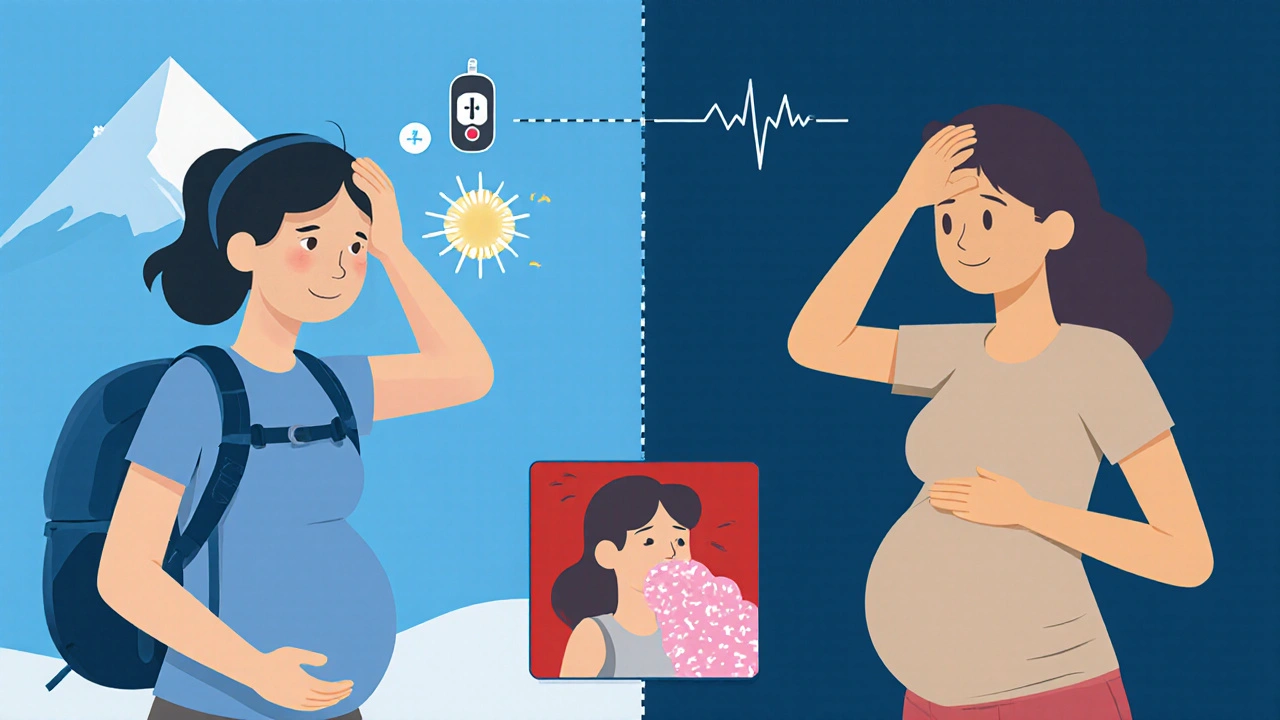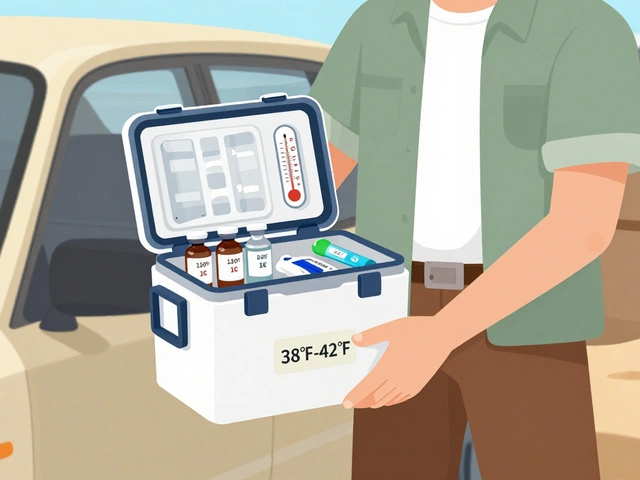Climbing a mountain or even a weekend getaway at 8,000 feet can feel magical-until you start coughing, feel dizzy, or notice a pounding headache. Now imagine dealing with those symptoms while you’re pregnant. That mix can be scary, but it’s also manageable if you know what to watch for and how to protect both you and your baby.
What is Mountain Sickness?
When you ascend to high altitude, the air contains less oxygen. Your body reacts with a set of reactions we call mountain sickness (acute altitude illness). The most common form is Acute Mountain Sickness (AMS), which shows up as headache, nausea, fatigue, and shortness of breath within hours to a couple of days after ascent.
Why Pregnancy Changes the Game
During pregnancy, a woman’s blood volume goes up by about 40‑50%, and the heart works harder to pump extra blood to the placenta. At the same time, progesterone makes the airway more relaxed, which can lower oxygen levels a bit. These physiological tweaks mean a pregnant traveler can feel the effects of altitude sooner and more intensely than a non‑pregnant counterpart.
Key Symptoms to Differentiate
Both AMS and early pregnancy can cause headaches and nausea, so it’s essential to know the tell‑tale signs that point to altitude trouble. Below is a quick side‑by‑side look:
| Symptom | Acute Mountain Sickness | Typical Early Pregnancy |
|---|---|---|
| Headache | Often severe, worsens with activity | Mild, usually constant |
| Nausea/Vomiting | Sudden, may be accompanied by vomiting of blood | Gradual, often part of "morning sickness" |
| Shortness of Breath | Disproportionate to effort, improves with descent | Usually mild, linked to increased heart rate |
| Dizziness | Feels like the room is spinning, worsens at rest | Occasional, tied to low blood sugar |
| Fatigue | Persistent, not relieved by rest | Common, improves after first trimester |
If you notice a rapid onset of severe headache, vomiting, or inability to catch your breath, treat it as possible AMS and act fast.

When Altitude Turns Dangerous: HAPE & HACE
In rare cases, AMS can progress to High Altitude Pulmonary Edema (HAPE) or High Altitude Cerebral Edema (HACE). Both are medical emergencies. HAPE fills the lungs with fluid, causing a cough that produces frothy pink sputum and severe shortness of breath. HACE leads to confusion, loss of coordination, and can progress to coma.
Pregnant women are especially vulnerable because the extra blood volume can mask early fluid buildup. If you notice any of these red flags, descend immediately and seek emergency care.
Safe Altitude Limits for Expecting Mothers
Research suggests that staying below 8,000 feet (about 2,400 meters) during the first trimester is generally safe for most women, provided they have no pre‑existing conditions like anemia or hypertension. After the first trimester, many obstetricians allow travel up to 10,000‑12,000 feet, but only if you’ve had a thorough check‑up and feel comfortable.
When planning a trip, consider these practical steps:
- Get clearance from your prenatal care provider. They’ll check your hemoglobin, blood pressure, and oxygen saturation.
- Acclimate slowly-spend at least one night at a moderate elevation (5,000‑6,000 ft) before hitting higher altitudes.
- Stay well‑hydrated; dehydration worsens AMS.
- Avoid alcohol and heavy meals before ascent.
- Carry a portable pulse oximeter to monitor oxygen saturation. Aim for readings above 95% at rest.
Nutrition and Hydration Tips at Altitude
Eating right can offset the strain altitude puts on your body. Focus on:
- Complex carbs (whole‑grain breads, oatmeal) for steady energy.
- Iron‑rich foods (lean red meat, lentils, spinach) to support the increased blood volume.
- Vitamin C (citrus, bell peppers) to improve iron absorption.
- Electrolyte‑balanced fluids-think coconut water or low‑sugar sports drinks.
Small, frequent meals help keep blood sugar stable, which can lessen both nausea and dizziness.
First‑Aid Plan: What to Do If Symptoms Appear
Having a simple, step‑by‑step plan can keep panic at bay.
- Assess severity: If symptoms are mild (headache, slight nausea), rest, drink water, and take a low‑dose acetaminophen if approved by your doctor.
- Monitor: Check oxygen saturation every hour. If it drops below 90% or you develop worsening headache, start descending.
- Descend: A reduction of 1,000‑2,000 feet often relieves AMS quickly. If you’re staying at a lodge, ask staff for transport.
- Seek medical help: If symptoms persist after descent, call emergency services. Bring your prenatal records, any medications, and a list of allergies.
Never ignore severe symptoms because you’re pregnant-you and your baby deserve prompt care.
When to Call Your Provider Before the Trip
Schedule a pre‑travel visit at least two weeks before you leave. Discuss:
- Your current trimester and any complications (gestational diabetes, pre‑eclampsia).
- Baseline hemoglobin and oxygen saturation levels.
- Vaccinations needed for the destination.
- Medication safety-some altitude medicines (like acetazolamide) are not recommended during pregnancy.
Having a written plan reassures both you and any rescue team that might get involved.
FAQs
Can I take acetazolamide for altitude sickness while pregnant?
Acetazolamide is generally avoided during pregnancy because it crosses the placenta and may affect fetal kidney development. Talk to your doctor about safer alternatives like slow ascent and hydration.
Is it safe to travel to the Himalayas in the third trimester?
Most experts recommend avoiding high‑altitude trekking after 28 weeks unless you have a specialist’s clearance. Even lower‑altitude destinations can become risky if you experience sudden swelling or shortness of breath.
How often should I check my oxygen saturation at altitude?
Check at least once every 2‑3 hours while you’re acclimating. If you feel any new symptoms, check immediately and consider descending.
Can a normal prenatal ultrasound detect altitude‑related problems?
An ultrasound can assess fetal growth and placental placement but won’t show altitude‑induced issues directly. The key is monitoring maternal oxygen levels and blood pressure.
What foods help prevent altitude sickness during pregnancy?
Target iron‑rich meals, vitamin‑C partners, and plenty of fluids. A snack of a banana with a handful of almonds provides potassium and magnesium, which can ease muscle cramps at altitude.
Traveling to high places while pregnant isn’t a no‑go, but it does demand extra care. By understanding mountain sickness, listening to your body, and planning ahead with your health team, you can enjoy breathtaking views without compromising your baby’s health.







Wow, this guide really covers the basics!! I especially appreciate the clear bullet points on hydration and oxygen monitoring!!! It’s helpful to see the altitude limits broken down by trimester, and the reminder to get a prenatal clearance is spot‑on. The table comparison between AMS and normal pregnancy symptoms is a nice visual aid. Thanks for pulling all of this together in an easy‑to‑read format!!!
Glad you found it useful! One thing to keep in mind is that individual acclimatization rates vary, so even within the “safe” altitude range some women may still feel light‑headed. It can be worth doing a short test hike a week before the main trip to see how the body reacts. Also, packing a small medical kit with plain acetaminophen (if approved) can save a lot of stress later.
Imagine standing atop a mist‑cloaked ridge, the world stretched out beneath you, while a tiny heartbeat within you whispers of new life. The sheer majesty of the mountains can stir both awe and anxiety, especially when your body is already juggling the demands of pregnancy. Altitude steals oxygen from the air, and pregnancy already stretches your circulatory system to its limits. This double‑whammy can turn a gentle headache into a pounding drum that refuses to cease. Nausea that once was a polite morning companion can erupt suddenly, accompanied by a dizzy swirl that feels like the world is tilting. Shortness of breath, normally a fleeting gasp after a stair climb, may linger even while you sit still, reminding you of the thin air around you. The body’s progesterone‑induced airway relaxation, while beneficial for fetal oxygenation, paradoxically makes you more susceptible to hypoxia at height. Every step you take becomes a negotiation between your desire to explore and your instinct to protect. Yet, knowledge is your ally; monitoring oxygen saturation with a pulse oximeter offers real‑time reassurance. Hydration, the simple act of drinking water, transforms into a potent shield against the cascade of AMS symptoms. Consuming iron‑rich foods not only supports the extra blood volume but also fortifies your oxygen‑carrying capacity. Slow, deliberate ascent-spending a night at 5‑6000 feet before pushing higher-lets the body adapt gracefully. If a severe headache spikes, remember that descent of just a thousand feet can melt the pressure like snow under the sun. In those moments, never hesitate to call for help; emergency services are more prepared than you might think. Above all, keep open communication with your prenatal provider, sharing your altitude plans well in advance. With careful preparation, the mountains can become a backdrop to one of life’s most profound journeys.
I think the main point is to get a doctor check before you go and to stay below the recommended altitude. Also bring a pulse ox and drink water.
this is super helpful i wish i knew this before my first trek lol staying hydrated and checking o2 levels is key cant stress enough
Honestly this whole "safe up to 8000 ft" thing sounds like a marketing ploy. If you’re pregnant, just stay home, no need to risk a fancy mountain view.
i grew up near the Rockies and we always used local herbs like ginger tea to settle nausea at altitude. also some indigenous communities recommend slow breathing exercises, they call it "pranayama" which can help both mom and baby.
The medical elite don’t want you to know that most altitude meds are being suppressed by big pharma. they claim acetazolamide is unsafe, but it's just a way to keep us dependent on their pricey alternatives. stay vigilant, question the guidelines, and demand natural alternatives!
It is incumbent upon expectant mothers to adhere strictly to evidence‑based protocols when contemplating high‑altitude exposure. Recent peer‑reviewed studies elucidate that maternal oxygen saturation below 95 % correlates with statistically significant reductions in fetal oxygen delivery. Consequently, pre‑travel evaluation should encompass comprehensive hematologic profiling, including serum ferritin and arterial blood gas analysis. Moreover, the recommendation to limit ascent rates to no greater than 300 metres per day aligns with established acclimatization standards. Failure to observe these parameters may precipitate acute mountain pathology, thereby endangering both maternal and fetal health.
Sure, ignore all the medical advice and hope for the best-what could possibly go wrong?
Not everyone needs to treat mountain travel like a high‑stakes mission. A lot of folks do fine at 9000 ft without any fuss, even in the third trimester. Maybe the guide is a bit overcautious.
Good points. Staying hydrated and checking oxygen levels are simple steps that can help a lot.
The government’s health guidelines are just another way to control our bodies, especially when they tell pregnant women to stay low. They want us to fear the mountains, to keep us from experiencing true freedom! Yet the data shows many women trek safely above 10,000 ft when they listen to their own bodies, not to bureaucrats. Stop buying into the fear‑mongering narratives, and claim your right to explore.